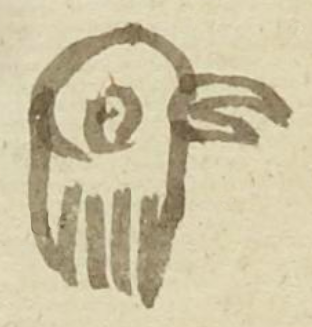Tzopilotl (MH579r)
This black-line drawing of the simplex glyph for the personal name Tzopilotl (“Turkey Vulture,” attested here as a man’s name) shows a bird's head in profile, looking toward the viewer's right. Its visible eye and its beak are both open. At the base of its head the feathers are rather spiky.
Stephanie Wood
The zopilote (Hispanized version of the Nahuatl) was a day sign in the calendar. This personal name, therefore, may have once had a numerical companion to the vulture, and perhaps this number dropped away over time--either inadvertently, or it was dropped to put distance between the name and the pre-contact era beliefs about the meaning of that day sign.
Stephanie Wood
luys.tzopillotl.
Luis Tzopilotl
Stephanie Wood
1560
Jeff Haskett-Wood
vultures, zopilotes, birds, pájaros, feathers, plumas
This is a distant shot of a large number of vultures in Sumidero Canyon, Chiapas, Mexico. Photo by R. Haskett, 22 April 2025.

tzopilo(tl), turkey vulture, https://nahuatl.wired-humanities.org/content/tzopilotl
El Zopilote
Stephanie Wood
Matrícula de Huexotzinco, folio 579r, https://www.loc.gov/resource/gdcwdl.wdl_15282/?sp=237&st=image
This manuscript is hosted by the Library of Congress and the World Digital Library; used here with the Creative Commons, “Attribution-NonCommercial-ShareAlike 3.0 License” (CC-BY-NC-SAq 3.0).



